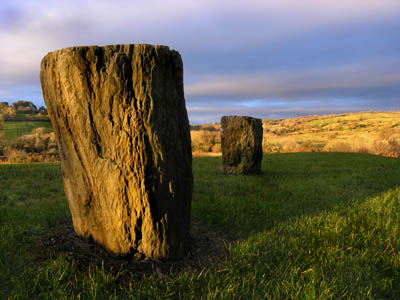Irland ist das Land der Sagen und Legenden. Ein Ire berichtet über das mystische Volk der Zwerge, das lange Zeit ungestört in Irland lebte, bis schließlich die Kelten ins Land kamen:
„We are taking about the fairies. When the Celtic man first arrived in Ireland the first thing he would have met was the little people, the leprachaun or the fairies as we call them. Immediately they went into battle with the Celt to protect their own land, naturally. They faught three years with some very very heavy losses on both sides. Eventually the high kings or the leaders or whatever of both sides got together and said listen: This fight, it's time we stopped because nobody is winner. So they sat down together and they chatted and they came up with a plan. The plan was that the little people would go underground and us, the big people, would stay overground. So the fairy said he had no problem with that on one condition: That he had sacred places of his own like the thorn bush to meet and the fairy forts and ring forts where they could have their parties. So the Celt agreed and the Fairy said: If anybody touches anyone of those places bad luck will be starting. So a thorn bush is a sacred place to fairies or little people. A thorn bush I wouldn't touch, and a fairy fort I certainly wouldn't touch.”

 |
|
Zeugnisse der irischen Megalithkultur, lange bevor die Kelten (ab etwa 500 v.Chr.) auf die Insel kamen: die archäologische Stätte von Ballycommane (County Cork) mit einem boulder-burial (der weißliche Quarzitbrocken links im Bild) und daneben zwei Menhire (standing stones). Solche vorgeschichtlichen Kultplätze, zu denen auch Steinkreise gehören, stammen aus der Bronzezeit oder sind sogar noch älteren Ursprungs. Das boulder-burial diente einst als Grabstätte, wohl für eine bedeutende Persönlichkeit. Der gewaltige Quarzitbrocken - der eigentliche Grabstein - ruht auf kleineren Steinen, liegt also etwas erhöht über dem Boden. Die beiden Menhire dienten vermutlich astronomischen Zwecken und ermöglichten es, durch die Beobachtung von Sonnenauf- und untergängen sowie Mondphasen einen Kalender zu entwickeln. Ganz am Anfang dieser Entwicklung stand dabei sicherlich die Bestimmung des jeweils kürzesten und längsten Tages im Jahresverlauf, also der Wintersonnenwende (21./22. Dezember) und der Sommersonnenwende (um den 21. Juni); hinzu kamen die Äquinoktien, d.h. die Frühlings-Tagundnachtgleiche (20. März) und die Herbst-Tagundnachtgleiche (22./23. September).